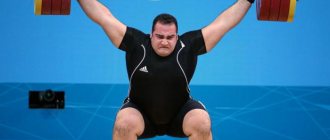Author: Timko Ilya - the ruler of the entire site and fitness trainer | more details >> Rod. 1984 Trained since 1999 Trained since 2007. Author and creator of the site tvoytrener.com. CCM in powerlifting. Champion of Russia and South Russia according to AWPC. Champion of the Krasnodar region according to IPF. 1st category in weightlifting. 2-time winner of the Krasnodar Territory championship in t/a. Author of more than 700 articles on fitness and amateur athletics. Author and co-author of 5 books.
Place in the author rating:
out of competition
(become an author)
Date:
2012-05-29
Views:
1,102,123
Rating:
5.0
| All articles by the author >> | Medals articles >> |
Articles are loading...
| Article medals: | article in TOP 50 | more than 100 comments | more than 1 million views |
Why medals are given to articles:
| Bronze medal: | |
| 1. The article is in the TOP 100 2. The article has more than 3. The article has more than 100 | |
| Silver medal: | |
| 1. The article is in the TOP 50 2. The article has more than 3. The article has more than 500 | |
| Gold medal: | |
| 1. The article is in the TOP 10 2. The article has more than 1 3. The article has more than 1,000 | |
Main muscles - pectoralis major Additional - triceps and anterior deltoids Difficulty - medium
What is "weightlifting"
Many people confuse strength sports. Weightlifting is one of the oldest strength disciplines. The essence of all movements is in releasing the bar: at some point the bar flies by inertia, and not under the control of the athlete’s strength. This is the main difference from powerlifting.
As a result, weightlifters develop more white muscle fibers in their bodies and develop explosive strength and sharpness, much like sprinters. By the way, weightlifters are very good at high jumping and running short distances.
Russian TA Cup
My friend, Ilya Popov, took part in the most serious competition in the country - the Russian Cup. The Cup was in Orel and took place last week.
I decided to provide moral support and go to Orel for company.
Met a minion:
After which we loaded into the car, drove 1200 kilometers and checked into a hotel:
Preparation and warm-up
Competitions at the national level are quite a serious event that requires a lot of preparation work. For an athlete, it all starts with a warm-up.
The loads are quite severe, many people use warming ointments to reduce the likelihood of injury:
After which the athletes begin warming up:
There are several warm-up platforms backstage. In general, it is impossible to do TA without a platform - in order not to waste energy, athletes throw the barbell after lifting. No floor can withstand such treatment, but there are special rubber platforms.
Ilya is surprised that he will have to lift the barbell:
For now, the point is, retro-chronicles are playing on all the screens, free people are sticking to the athletes of yesteryear:
Both behind the scenes and on the stage there are things with a special powder - magnesium, with which athletes smear their hands so that the barbell does not slip. Those who wish can also apply the soles of weightlifters (these are special shoes for weightlifters, with an anatomically correct instep and arch support):
A doctor is required to be on duty at every competition:
At all national level competitions there is a jury that can appeal the judges' decisions:
Before the start of the competition, the athletes are brought onto the stage and introduced: “Ilya Popov, master of sports, Samara, bronze medalist of the Russian Cup 2013, born in 1988. Own weight – 76 kilograms 600 grams”:
In general, there are quite a few weight categories in weightlifting: 52, 56, 69, 77, 85, 84, 105 kg and super-heavyweights over 105 kg. Athletes compete with their peers in weight.
The age of active athletes is up to 35 years (more than in almost all sports). This means that after 35 years of age, a weightlifter can take part in special competitions for veterans (where a division by age group is added to the division by weight). Veterans can also take part in regular competitions and quite often outshine the youth.
After the presentation, 10 minutes are given for the official warm-up:
Most athletes are already warmed up by this point - it is unrealistic to fully warm up in 10 minutes and prepare for the maximum weights for yourself.
Special assistants put on and take off discs during competitions. Usually these are young people, novice weightlifters of the city in which the competition is held:
During the warm-up, the judging team is introduced, after which the judges greet the jury:
Representatives of the Russian Weightlifting Federation are present at major competitions:
Technical controllers are ready:
The sound guy brought the girl and, apparently, is also ready to start:
There are special technical assistants behind the scenes - they accept applications from athletes.
The competition consists of two exercises – the snatch and the clean and jerk. Each participant is given 3 snatch attempts and 3 push attempts. The goal is to collect the maximum amount.
You can increase the weight from attempt to attempt, but you cannot decrease it. Weightlifters perform in order of increasing weight of the barbell. Ilya announced 135 kilograms in the clean and jerk and 165 kilograms in the snatch (he should be sixth in the snatch, seventh in the clean and jerk, there are 13 participants in total).
After completing (or not completing) the next approach, the coach must submit a request for a new weight to the technical assistant (or inform that the new attempt will be with the same weight). One minute passes between lifting the barbell.
If the athlete follows himself (he couldn’t cope with the lift and there is no one willing to approach the same weight again), he is given two minutes to rest.
The assistants are ready to start:
Our athlete, meanwhile, is warming up with all his might:
Weightlifting competition calendar 2020
All upcoming Russian and international weightlifting competitions for 2020 will be presented here. The competition schedule will be updated as information becomes available, follow the changes on the website.
Weightlifting competition calendar in PDF format.
Current standards for weightlifting.
| Month | Number | Name of competition | Age group | Location |
| January | 18-25 | Russian Championship | Juniors and junior girls 15-18 years old (born 2002-2005) | Stary Oskol |
| Juniors and junior girls 19-20 years old (born in 2000 and 2001) | ||||
| February | 03-10 | Cup of Russia | Men and women | St. Petersburg |
| February | 11-17 | All-Russian tournament in memory of ZTR M.S. Okuneva | Boys and girls 10-12 and 13-15 years old | SOB Chekhov |
| February | 22 | Competitions for athletes of older age groups | Men and women 35 years and older | Dubna |
| March | 05-15 | World Championship | Juniors and junior girls 15-20 years old (born 2000-2005) | Egypt |
| March | 06-08 | Moscow Region Championship | Boys and girls 13-17 years old (born 2003-2007) | Kolomna |
| March | 20-22 | Moscow Region Championship | Men and women | Lyubertsy |
| March | 23-30 | Russian Championship | Boys and girls 13-15 years old (born 2005-2007) | Stary Oskol |
| Boys and girls 13-17 years old (born 2003-2007) | ||||
| April | 01-12 | Europe championship | Men and women | Moscow |
| April | All-Russian competition among students | Juniors and junior girls 17-25 years old (born 1995-2003) | Moscow | |
| April | 16-20 | Spartakiad of students of the Central Federal District of Russia (II stage) | Boys and girls 15-17 years old (born 2003-2005) | Stary Oskol |
| April | 23-26 | Championship of the Central Federal District of Russia | Men and women | Stary Oskol |
| June | 05-07 | Moscow Region Championship | Juniors and junior girls 15-23 years old (born 1997-2005) | Orekhovo-Zuevo |
| June | 22-29 | Russian championship | Men and women | Grozny |
| July | 05-10 | Spartakiad of Russian Students (final) | Boys and girls 15-17 years old (born 2003-2005) | Belgorod |
| July | 13-20 | Russian Championship | Juniors and junior girls 15-23 years old (born 1997-2005) | Tomsk |
| July August | 24-09 | Olympic Games | Men and women | Japan |
| August | 18-30 | European Championship | Boys and girls 13-15 years old (born 2005-2007) | Latvia |
| Boys and girls 13-17 years old (born 2003-2007) | ||||
| September | 12-20 | European Championship | Juniors and junior girls 15-20 years old (born 2000-2005) | Finland |
| Juniors and junior girls 15-23 years old (born 1997-2005) | ||||
| September | 20-24 | World Student Championship | Boys and women | Korea |
| October | 09-11 | Open Championship of the SShOR Moscow Region | Boys and girls 10-14 years old (born 2006-2010) | |
| October-November | 30-01 | Moscow Region Championship | Juniors and junior girls 15-18 years old (born 2002-2005) | Kolomna |
| november | 11-18 | World Championship | Boys and girls 13-17 years old (born 2003-2007) | Peru |
| november | 27-29 | Moscow Region Championship | Boys and girls 13-15 years old (born 2005-2007) | Orekhovo-Zuevo |
| December | 18-20 | Moscow Region Cup | Men and women | Lyubertsy |
Snatch
Three judges decide whether each approach was successful. They find fault with the athletes’ technique and equipment. I remind you that you cannot press the barbell by force - there must be release
from the weight, a fraction of a second of free flight of the barbell upward. A weightlifter is very similar to a juggler - his task is to throw the barbell and take a place under it while the barbell flies upward.
The judges are ready, the competition begins:
There are three judges; in controversial cases, decisions are made by a majority vote.
The essence of the “snatch” exercise is simple: you need to lift the barbell from the platform and sit under it at the moment of flight. Then stand with the barbell at full height and fix the barbell in this position.
The athlete adjusts and takes the starting position (the weight of the bar in the photo is 130 kilograms):
He pulls it out and sits down:
He gets up, the approach is counted:
Weightlifting is primarily about working on perfect technique. Think for yourself - the barbell should fly along an ideal trajectory; at the slightest deviation, the weightlifter will drop the projectile forward or backward.
The first thing we were taught during TA classes was to jump out from under a barbell falling from different positions =)
This is why I don’t have photos of Ilya’s performance - I shot a video with a separate camera so that they could watch the performance with the coach and work on mistakes for each approach.
Before Ilya’s performance, one of the athletes suffered his first serious failure – the so-called “steering wheel”. The weightlifter failed a single approach in the snatch and finished the competition with a zero result. All the preparation, all the effort and the trip - all in vain:
Ilya also almost failed, but on the third attempt he managed to lift the weight of 135 kg.
After him came more prepared athletes. The judges are seriously worried:
Please note that I am not saying that athletes are “stronger”. They are more prepared; strength and preparation are radically different things.
All my experience says that to successfully perform at national-level competitions, you need to combine all three conditions: genetic predisposition, powerful pharmacological support and an inhuman amount of work over many years.
While the leaders are finishing the snatch competition, Ilya begins to warm up the clean and jerk with light weights:
Technical assistants are accepting applications for extreme approaches in the snatch, passions are heating up:
By the way, weightlifters are very, very flexible. Look at this photo and keep in mind that the weight of the barbell in the photo is 150 kilograms. Try sitting like this with a mop at home, I think the chances of success are low:
In the snatch, the two leading athletes showed a result of 150 kilograms. Ilya takes seventh place and is 15 kg behind the leaders.
When lifting the bar off the floor, worry about angles, not speed.
Correct execution of the snatch or clean and jerk begins with the removal of the bar when you lift it off the platform, and this is where the problem lies for most beginner weightlifters, especially those who have already done deadlifts before. In the deadlift, lifting the barbell off the ground at maximum speed is one of the key points when performing the exercise, especially when there is a lot of weight on the barbell. So it is normal for a person to think that the quick release of the barbell from the platform during the snatch or clean will also be a decisive factor. In fact, this is not at all necessary.
“There is some progression when teaching CrossFitters how to snatch and clean a barbell. And the first stage is to get rid of this desire to quickly remove the barbell from the platform. says Pendlay. – In weightlifting, the speed with which you lift the barbell to hip height is less important than your position at the moment the barbell reaches that height.
And all because it is this position that determines whether you can lift the barbell above your head. For beginners this looks somewhat unusual. They believe that the speed at which the bar lifts off determines whether the approach will work or not. Of course, it's good if you are strong and can lift it quickly, but only if you maintain the correct position and angles. But if the bar moves too quickly, then you may miss the moment of detonation and you simply will not be able to lift the bar. If the bar moves slowly, but when you reach hip height you are in a great position, then you have a much better chance of success.”
The position Pendlay is talking about takes only a moment in the exercise. The bar of the bar should be directly above your heels, with your knees in front of the bar and your shoulders behind - this is the best position to apply maximum power to lift the bar. “It's common for athletes to hang too much over the bar or put too much weight on their toes,” Glenn says.
Coaching Tips
Start with your shoulders directly above the bar while the bar is still on the floor. “I don't teach people where their pelvis should be, because it all depends on the structure of the body,” says Pendlay. “If you stand over the bar with it against your shins, and then you squat until your shoulders are above the bar, your pelvis will automatically be in that position. Your knees should be in front of the bar and your shins should be at an angle. Your arms hang straight down to the sides of your knees, and your pelvis is where it should be, which for most people will feel lower than a natural position.”
From this point on, the lift line becomes critical. The bar should seem to be moving towards you, because this is the only opportunity to get into the ideal position for the lift when the bar is over your heels.
“You can't let the bar move forward,” says Pendlay. “Because if she goes forward, how can we achieve a stable and powerful position in the hips?”
“What a lot of people do is instinctively try to get into a position where they think they can lift more weight while positioning their pelvis a little higher than necessary. And they will, of course, be able to lift a large weight off the floor to mid-thigh, but by doing so, they will change the position of the bar, so that they will not be able to apply maximum effort on the next stage of the lift. If you have a barbell weighing 50 kilograms, then you can do anything with it. But with a weight of 150 kilograms, with this approach you will no longer be able to cope. Once the bar gets really heavy, you have to rely on the laws of physics instead of trying to beat them with brute force.”
Clean and Jerk
One of the leaders in the snatch, Victor Goetz, rests between the snatch and the clean and jerk and receives the last instructions from the coach:
The usual break is 10 minutes, but the athlete has time to rest and will skip ahead of many less prepared athletes.
For some people, warming up is quite difficult:
Someone receives current technique recommendations from a coach:
Ilya warms up very leisurely:
Working with very light weights:
The jerk is more complex at first glance, but in reality it is a technically simpler exercise.
The athlete takes the starting position (bar weight – 160 kg):
Throws the barbell onto his chest (at this moment the release
, the athlete stretches out to his full height and then suddenly sits down under the bar):
Standing up with a barbell on his chest:
And he pushes the barbell up with his whole body (at this moment another release occurs):
The task is to take the barbell with your arms extended above your head. If your arms are bent at the elbows and then straightened, the approach no longer counts.
Typically, athletes push the barbell “in a straddle position,” spreading their legs back and forth as they release the weight of the barbell. This allows you to catch a barbell that has moved slightly forward or backward. But some people throw - they simply throw the barbell up without spreading their legs. Photo of a weightlifter doing a low squat (not mine). This is when the weightlifter pushes the barbell upward with his body, at the moment of release he pushes off the barbell with his hands and sits down low, while simultaneously absorbing the barbell flying down:
The final part of the clean and jerk is to collect the legs from the spreader and fix the barbell in this position:
Before going on the platform, each athlete prepares in his own way. Typically, trainers use the following techniques.
They slap the calves and thighs hard to disperse the blood:
Tinder ears:
And they massage the trapezoid strongly:
The trapezius muscle is involved in the final stage of the snatch and lifting the barbell to the chest of the clean and jerk - the athlete stretches out with the barbell to his full height, stands on tiptoes and helps himself with the trapezius. Look at the snatch technique, pay attention to the fourth photo from the top (photo not mine):
Athletes continue their performance in the clean and jerk:
Workplace of the presenters, who announce the weights and the order of approaches:
Ilya lifted 165 kilograms on his first try, but, unfortunately, was unable to improve this result. The total amount is 300 kg. The athlete is dissatisfied with himself:
Technical assistants begin to accept applications for the clean and jerk from the most powerful athletes, the outcome of the competition is near:
Unexpectedly, the doctor removes one of the leaders due to an internal tissue rupture (I didn’t have time to take a photo, a small bruise visually appeared on my leg) - last year’s champion, Mikhail Gobeev, will not be able to continue the competition.
There is only one clear contender for the butt!
The inspired Victor Goetz lifts 185 kilograms in the second approach and refuses the third, thereby collecting an amount of 335 kg.
Ilya came sixth and was quite upset, but nothing! Next year we will show better results!
Benefits of working with a barbell[edit | edit code]
This projectile also has a number of advantages and disadvantages, let's start with the pros.
- Versatility
The barbell is a universal equipment, it may not be the same as dumbbells, but in comparison with exercise machines it definitely wins. Power units are designed for one or two movements and have a rather limited range of motion. The barbell allows you to strengthen almost all the muscles of the body with a wider range of resistance. In addition, it is much cheaper and takes up less space than any home exercise machine.
- Simplicity
A barbell is a stick with two ends with a weight attached to each of them. Its use is simple and straightforward, and its robust design allows the use of large weights. The plates are always fixed (using special clamps) and remain stable throughout the entire exercise.
- Adaptability
Adding weight is an important point in the progress of muscle mass and increasing strength. As the body gets stronger, it needs more resistance, in the form of additional weight, to progress towards its goal. Dumbbells are often limited in this regard and do not allow you to “reach the handle.”
- Better athlete power development
Everyone knows that the body responds best to basic exercises by growing. They involve more than one joint and involve many muscle groups. Almost the entire base is tied to a double-edged sword, so it is the barbell that allows you to develop the power indicators of an athlete many times better (in comparison with dumbbells/simulators).
- Symmetry at work
Most barbell movements should be performed symmetrically in the lateral plane. For example, exercises such as squats, bench press - in them both arms/legs must perform the same actions. The barbell forces the body to “tighten” its weak points so that there are no various distortions and displacements during movements.
- A surge of anabolic hormones
An athlete's muscle growth depends on the level of concentration of anabolic hormones, in particular testosterone and growth hormone. Multi-joint exercises promote much greater release, unlike dumbbells and exercise machines. Therefore, the potential for volumetric growth from working with a barbell is much higher.
Disadvantages when working with a barbell[edit | edit code]
- Asymmetrical execution
Very often you can observe asymmetry in the performance of symmetrical exercises, for example in the bench press - when one arm is clearly ahead of the other due to the unevenness of the applied shoulder force. This leads to the appearance of a dominant side and inharmonious development of the muscle group from an aesthetic point of view. The barbell does not allow you to achieve deep muscle contraction at the top position of the positive phase, as is the case with the chest and shoulder press.
- Reduced security
The barbell is very difficult to get rid of, unlike dumbbells. Moreover, when weights increase, the likelihood of serious injuries increases sharply.
- Limited range
The bar allows you to work only in a limited range and only in one plane of movement (up and down). It prevents the muscles from “running wild” and limits their degree of freedom (wider trajectory). All this leaves an imprint on the athlete’s form. For example, doing one bench press will (over time) flatten your chest.
Awards
Immediately after the competition, the awards ceremony takes place:
Typically, this ceremony is performed by famous athletes of past years. In the center of the photo is Boris Selitsky, the 1968 Olympic champion, who set 2 world records:
TA and girls
Quite often I hear the opinion that weightlifting is not a female sport at all. I fundamentally disagree with this! Weightlifting gives flexibility, speed and sharpness. Volumetric muscles and “chemistry” are not at all necessary components.
But flexibility, endurance and a good figure are very frequent companions of weightlifters. I wanted to show what the girls looking like competing in the 53 kg weight category - but, unfortunately, all the photos on a point-and-shoot camera in poor lighting didn’t turn out well. Therefore, here are pictures from the network.
Once (there is 75 kilograms on the bar, most men will not only not break, but will not even be able to bench press this weight):
Two:
Competition regulations
Technically, everything happens according to the well-known weightlifting canons. The organization conducting the competition (most often a federation) develops a separate regulation for it. The subject of the competition is the Olympic all-around, which includes two exercises: the snatch and the clean and jerk.
Applications for participation of teams and athletes are submitted well in advance (at least one day) before the competition. Participant cards are filled out. Competitors compete among themselves in weight groups. If there are a large number of them in a weight group, they are divided into subgroups: A, B, C, etc. in relation to the rating of the athletes (i.e., their performance.) When submitting an application, each athlete is assigned an individual competition participant number.
During the draw, the order of weighing and calling participants is determined. This is how weightlifting formalizes competition. A championship or other international competition presupposes an organizational beginning - the selection by each team of its representatives participating in the draw and weigh-in. During competitions, team representatives are located on special benches. They are responsible for discipline in the team.
Each weight category (subgroup) competes for one day. First the athlete performs a snatch, then a clean and jerk. Three attempts are allowed to complete each exercise.










